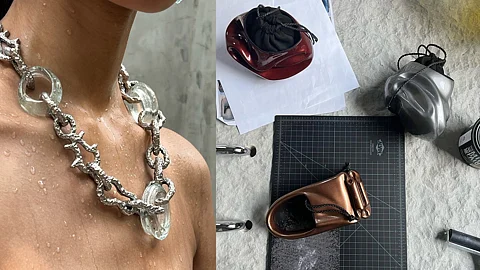
- HOMEGROWN WORLD
- #HGCREATORS
- #HGEXPLORE
- #HGVOICES
- #HGSHOP
- CAREERS
- ABOUT US
- CONTACT US

When Delhi-based designer Devanshi Jain was growing up, she lived in a home shared by three generations with a lot of history. Filled with relics like hand-enameled chandeliers, life-size alabaster figurines, ceremonial silver, time-worn clocks, and the textures and details of fine carpets, embroidered textiles, and inlaid wood lent their materiality to her eye for design.
A large part of Devanshi's practice is shaped by the emotional charge of that world or as she puts it, "...by the intimacy of growing up among family members who dressed deliberately. Bespoke savile row tailoring, the most exquisite toosh shawls, saree fabrics brought back from france on business trips; that sensibility continues to surface in what i make."
Like an emotional prompt, Devanshi's design process begins with form following the feeling. And then comes the exploration of materials that can turn that impulse into form. "I work experimentally, allowing form and fabrication to evolve through trial while testing what a material can endure, what it can hold, how it might behave on the body," she shares.
This leads her into a collaborative process with an archive of biomaterials that she has built for herself which contains everything from hemp fibre-based bioresin, pigments derived from milk protein, biotextiles spun from plant cellulose, leathers engineered from fruit and vegetable waste, and foams developed from algae, to found materials, recycled glass, and reclaimed metal; each with its own temperament.
All of Devanshi's collections are autobiographical in nature. "...each 'chapter' is an emotional record, and each object is a way of holding what can’t always be said," she notes. Titled after her New York apartment, '29 L' stemmed from a disquieting encounter that led Devanshi to question themes of control, surveillance, and bodily vulnerability. With structured, uniform-like silhouettes crafted from cactus-based biomaterial and foft embroidery held in rigid form, she reclaimed space through surface.
Another chapter examined the idea of the gilded cage and the constricting nature of lineage. The designer sourced antique tapestries from England that echoed the dense, ornamental textiles of her childhood home; heavy with the weight of inherited taste and stitched them into corsets, paired with reclaimed metal plated in gold, forming cage-like structures that evoked both opulence and suffocation. Devanshi calls this an exploration of how beauty can conceal control.
A later chapter of jewellery, made with recycled glass, was shaped by meditations on change and impermanence. The droplets, resembling ice, underscored its ephemerality. Prompted by the departure of the designer and her sister from their family home after marriage, an unreleased chapter reflects on their mother’s experience of an empty nest. Fragile and intimate nest-like objects woven from tomato-based bioleather, evoke both the tenderness and the ache of letting go.
Devanshi’s most recent work has pushed her deeper into the possibilities of regenerative design, particularly through experiments with algae-based matter. These surfaces are volatile; a trait the designer does not see as design failure, but as philosophical provocation. “The algae-based matter I’m working with is responsive and unstable — it warps/shifts/reacts and likely won’t make it to the shelf in its raw form,” she explains. “But that volatility is what excites me. I’m not chasing perfection or permanence with this surface treatment. I’m trying to build a system where breakdown and repair are part of the language.”
Where most of luxury is defined by rare, inert materials and the dullness of 'elegance' Devanshi's neo-luxury label proposes a radical reorientation. Her work invites us into a realm where surfaces bruise, warp, and respond. It’s an aesthetic that feels almost primordial: part science, part sorcery and rooted in the decay, renewal, and the deep intelligence of natural systems. Through her unique alien forms and biomaterials, Devanshi approaches luxury as sensorial speculation while building a future where beauty is unstable, organic, and alive to the touch.
If you enjoyed reading this here's more from Homegrown:
Where Fabric Takes The Lead: Inside Studio Medium’s World of Textile First Design
Where Fabric Takes The Lead: Inside Studio Medium’s World of Textile First Design
A Homegrown Studio Is Making Sustainable & Design-Forward Furniture Out Of Mushrooms
